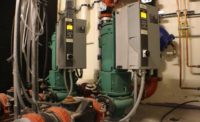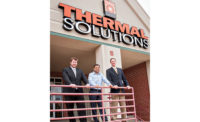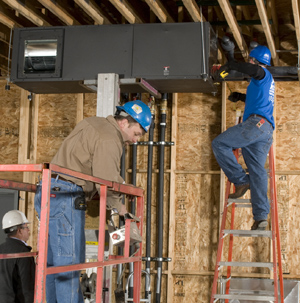
Area Mechanical’s Bill Churnick (left) and Brett Mead
install a ClimateMaster Tranquility geothermal system.
For the owners of a new Rockford, Ill., strip mall, maintaining a low carbon footprint was the key to unlocking profit. Higher initial costs were overcome by the long-term benefit of reduced energy need and the promise of continually climbing energy rates.
“The mall owners wanted to get as close to LEED specifications as possible,” saysBill Sprague, project manager for Rockford-based Area Mechanical. The 28-person firm has concentrated on design/build commercial work, from grocery store refrigeration to hospital and school HVAC systems, for the past 20 years.
To provide high-efficiency HVAC to the 12-business suburban complex (Rockford is about 80 miles north of Chicago), the owners approved a plan to install a network of water-to-air geothermal systems, each piped to a large main serving as the “thoroughfare.” This allows each system to pull and deposit Btu-rich fluids as needed. With a total capacity of 90 tons, the strip mall project called for an extensive geo-exchange field.
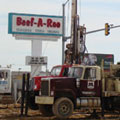
A 64-well geo-exchange
field was drilled under what is now the mall’s parking lot.
Drilling Away
Long before the framers and electricians appeared, three large drilling rigs rolled onto the jobsite to punch a field full of holes. They set to work, drilling 64 closed-loop vertical boreholes in an area now covered by asphalt and used as the strip mall’s parking lot.To retain all of the green, energy-efficient heating and cooling, a tight building envelope was designed. The building was heavily insulated and high-quality, low-E windows were specified. Awnings are installed over all the windows and doors, and the flat roof is white to reflect the majority of the sun’s radiant energy in the summer.
“We were under the gun for most of the project,” Sprague says. The slab for the 12-shop building was poured in August 2009, and the geo-exchange field needed to be complete by October, leaving just enough time to pave the parking lot before asphalt plants closed for the year.
“The geo-exchange field takes up the entire parking lot,” addsRyan Kerry, who, along with his brother,Brady, is part owner of Carol Stream, Ill.-based Great Lakes Geothermal. As the drilling subcontractor, Great Lakes spent 3-1/2 months on the job to drill all the boreholes and trench the lines to the building. Great Lakes also installed the U-tubes, and filled the boreholes with bentonite grout.
At one time, Great Lakes did mostly residential water-well drilling, but with the collapse of the new housing market, nearly all its work shifted to geo drilling, chiefly in the northern Illinois market.
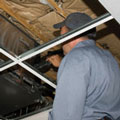
Area Mechanical’s Bill
Churnick performs system diagnostics on an installed geothermal unit.
Average loop temperatures in the winter are in the low 40s (degrees F), and in the 60s to 70s throughout the summer. The boreholes were set at about 20 feet from each other. This allowed greater-than-average distance between holes, and yet over time would help to stabilize ground loop temperatures year-round by providing sufficiently cool temperatures for summer operation. It would also serve as a heat source with plentiful Btu to be tapped into for winter operation.
For each ton of heating and cooling capacity, there’s approximately 180 feet of bentonite grout-filled borehole. “Illinois state code mandates that all geothermal boreholes are grouted,” Kerry explains.
Area Mechanical started the project with a thorough conductivity test. Nobody was looking to waste money by drilling an oversized exchange field or, worse yet, come up short on capacity if the field was undersized.
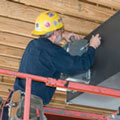
Sheet metal worker Ron Erbe is shown attaching
the electrical backup heat element.
On the Inside
The first shop to move into the mall was a Subway restaurant. The 2,800 square-foot eatery is heated and cooled by two ClimateMaster Tranquility geothermal systems suspended above the finished ceiling. One is a 3-ton TTH038, while the other is a 4-ton TTH049. Both are hung from the roof trusses.“Initially, we considered having a primary pumping system with continuous flow through all the wells and all the units, but later discarded the idea, even though we knew there’d be greater overall system efficiency if we circulated fluids that way,” Sprague says. “But the owner of the building insisted on having the ability to split up the utility bills. A primary pumping arrangement would have allowed for only one power meter.”
Jeff Hurst, geothermal product manager at Connor Co., Area Mechanical’s geothermal equipment supplier, notes a total of eight circuits are present, each comprised of eight, 2-inch geothermal loops that are connected or fused together in the geo-exchange field.
Area Mechanical heat-fused all the geothermal lines. Reverse return piping was used to run each circuit into the building. The tubing starts at 1-1/4 inches at the first well, and steps up as it joins the other wells. Two-inch tubing is used to run from the last well into the building. On the return side, the same tapering process is used, only in reverse order. This assures an even draw from all eight wells connected to the circuit. The geo-exchange medium – 1,800 gallons for the entire geo field and strip mall – is a 20% methanol mix.
The high-density polyethylene vertical U-tubes, or loops, and the connecting geo pipes that are butt- or socket-fused to them (which transport fluids to and from the building), were manufactured by Centennial Plastics.
Area Mechanical’s butt-fusion machine-used to join geo pipes, typically from the boreholes to the horizontal, trenched lines-is made by McElroy.
“Once the circuits reach the building, they join a 4-inch main, or header, that all the units individually draw from,” Hurst says. “It’s not a continuously running body of fluid. Fluids circulate only when there’s a call for Btus.”
To make sure that the heating and cooling costs were distributed fairly, each shop has its own flow center wired to that tenant’s power meter.
“The pump arrangement we ended up using gives each tenant the ability to monitor their own energy use, hopefully making them a little more energy-wise,” Sprauge states. “That was the building owner’s intent and it appears that it’s worked very well.”
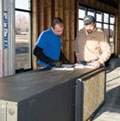
Area Mechanical’s Brett Mead (left) and Bill
Churnick look over job blueprints.
The Benefits Of Experience
Hurst points out the building owner was saved a good deal of drilling expense.“Since all the geothermal units share all the holes, each hole is being used to its full capacity,” he says. “We were able to save about 20 feet of vertical borehole per ton of capacity on this project because of the way the system is piped.”
With an average flow rate of 3 GPM per ton, the Subway’s 7-ton heating and cooling systems, when running at full tilt, require up to 21 gpm.
The exchange field feeds numerous ClimateMaster water-to-air units throughout the mall. Not all have been installed yet, because not all the spaces are currently rented.
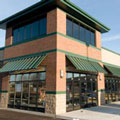
The mall features a network of water-to-air
geothermal systems.
Sprague added the Schedule 80 PVC four-inch header, inside, is manufactured by Charlotte Pipe. A Taco air separator was installed at the highest point in the piped system. A 4-gallon Watts Regulator expansion tank is connected to the header line.
Mike Sabin, a co-owner of Area Mechanical with PresidentGene Mead, feels the firm’s previous experience in geothermal helped it with the strip mall project.
“The complex in Rockford was our first geothermal strip mall, but it wasn’t our first commercial geothermal rodeo,” Sabin says. “Area has taken on and successfully completed firehouses, libraries and schools all around the greater Chicago area. Those experiences helped put this job together in short order.”
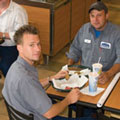
Area Mechanical’s Bill Churnick, Mike Sabin,
Brett Mead, Tim Macke and Zach Stohr.
Embracing Technology
The Rockford strip mall installation, in the purest sense, represents the coming together of not-long-ago separate disciplines: geothermal, hydronic, HVAC and plumbing.Area Mechanical – like many mechanical firms today – didn’t think twice about taking on the challenge of connecting incoming geothermal loop lines to indoor HVAC systems. Area’s expertise in hydronics permitted the skillful tying together of all systems, making them work as one with superb energy efficiency.
Of course, if radiant heat, snow melt or domestic water were connected to the mall’s geothermally heated system, all possible uses would have been explored.
Yet in today’s energy-conscious environment, it’s not uncommon for installing contractors or plumbing and mechanical engineers to explore broader uses of these new technologies.

